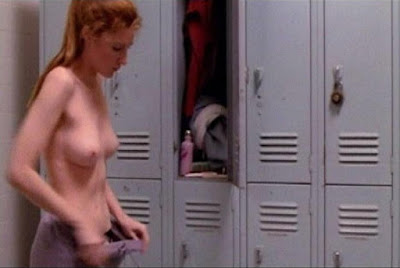Copyright 2011 by Gary L. Pullman
Context helps to determine how onscreen nudity registers--how, in other words, a moviegoer interprets its significance--and the context depends, in large part, upon the movie’s genre. For example, nudity in a romantic movie will be interpreted quite differently than nudity in a horror movie. However, context is more refined than simply a type of fiction would determine. The setting of the movie and other elements also suggest how onscreen nudity should be interpreted.
In Re-Animator, Megan Halsey (Barbara Crampton) is shown lying on her back, upon a steel examination table that is covered with a light-blue sheet. She could be in a hospital, coming to, or going from, surgery, but her situation is actually far worse: she is in a morgue, an unwilling potential participant in a madman’s quest for reanimation.
Surgery is frightening because its outcome is uncertain. Often, patients survive operations and thrive. Sometimes, however, they die on the operating table or, if they survive a botched surgery, they live out their days horribly disfigured or disabled.
As frightening as a hospital tends to be, however, a morgue is much more unnerving, for morgues are, by definition, associated with death. To be on a metal table in a morgue is anything but reassuring--especially under the conditions in which Megan finds herself.
Whether her attacker is a demon or a poltergeist is unclear, but Carla Moran (Barbara Hershey) emerges from an assault by an invisible rapist with bruises and injuries (The Entity). Her psychiatrist, Dr. Sneiderman, believes that Carla has caused these injuries to herself and that the “entity” whom she contends attacked her is but a delusion. As a child, she was sexually abused, becoming pregnant as a teenager. She also witnessed the violent death of her first husband. Her psychaitrist believes that these traumatic events have caused Carla to hate herself and to take her hatred out upon herself in violent displays of hostility and rage. However, moviegoers witness the attacks that Carla claims occur, seeing, before their own horrified eyes, the deep indentations in her breasts that the invisible entity makes during one of its terrifying assaults.
The juxtaposition of an invisible predator and a flesh-and-blood victim--and a nude one, at that--creates great tension, as audience members wonder whether they, too, could be similarly attacked by a ghost or demon that no one but they themselves can see--or feel. The indentations in Carla’s breasts, like the bruises and injuries to her body, witnessed by moviegoers, make it abundantly--and horrifyingly--clear that the entity is real, for, if it were not, it couldn’t grip Carla’s breasts, bruise her flesh, or injure her body. By reflecting the reality of the fleshless and invisible monster that assaults her, Carla’s nude and battered body magnifies the viewer’s own fear and dread, for, were the entity’s presence not revealed by these signs of its attendance, it would be easy to suspect, as the psychiatrist does, that Carla is hallucinating. The film does not allow this option. The entity is known by its effects upon Carla’s flesh and is as real, therefore, as she herself. The reality of the entity is the movie’s source of horror.
In Cat People, legend has it that a werecat transforms into a leopard when it has sex with a person, regaining its original human form only when it kills a person. The film plays upon fears of both incest (the werecats are incestuous) and bestiality, with the nude and sensual bodies of Irena Gallier (Nastassja Kinski) and zoologist Alice Perrin (Annette O’Toole) temptations that Irena’s brother Oliver, who is also Alice’s colleague and boyfriend, is unable to resist. Their nudity gives flesh, as it were, to the horrific temptations of incest and bestiality that haunt the decadent Oliver--indeed, their nakedness may well likewise tempt the viewer who, as voyeur, more or less willingly watches these dark and twisted, if sensual and seductive, sexual obsessions and acts.Good girls don’t have sex. They don’t get naked, either, except in socially sanctioned places and situations, such as the shower or their doctors’ offices. This belief, whether founded in reality or naiveté, is the basis for the shock that moviegoers feel when an actress with a wholesome image like that of Katie Holmes (The Gift) disrobes onscreen, and this shock, one may argue, is transferred to the girl-next-door character that she portrays--or, at least, appears to embody, as Holmes does in playing the innocent-looking, but sexually promiscuous, Jessica King, the local high school principal’s wholesome (-looking) fiancée. Her nudity and her innocent image contrast sharply, reminding filmgoers, once again, that, far from always inhabiting an ugly form, evil can, indeed, cut a strikingly beautiful figure; appearances can be deceiving.
Mathilda May may look a bit pale, but she also looks the very picture of health. Young and beautiful, she seems far too innocent and lovely to be a bloodsucking fiend, but, as a female vampire in Lifeforce, she is just that--as she proves again and again, flitting bat-like, from one host to another to relieve them of their life force. Beauty is, once again, a red herring, or false clue, suggesting that, in seeking evil, one must look elsewhere than the lovely face and form of Mathilda May, when, in fact, in her beautiful countenance and figure, they have encountered both true and deadly evil.
In horror films, nudity is a reminder of humans' (including moviegoers’ own) mortality; as a blatant exposure of the flesh, nudity can also highlight its opposite, the invisible spirit; nudity can signify the attractiveness of evil; and nudity, especially the nudity of a beautiful young, but wicked, woman, can suggest the absurdity of believing that beautiful people must also be good people.
The display of naked bodies in horror movies can, and does, accomplish more, as I will demonstrate in additional, future posts concerning the genre’s not-so-gratuitous nudity.









No comments:
Post a Comment